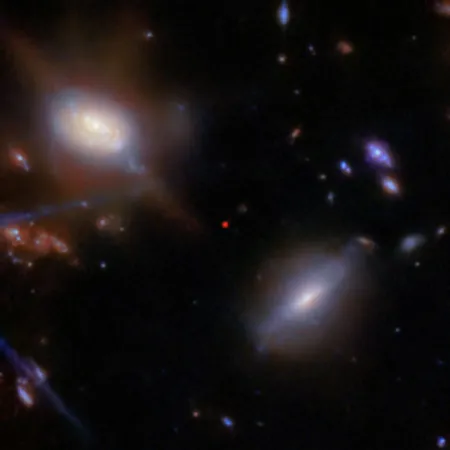
Groundbreaking Discovery: Webb Telescope Unlocks Secrets of Early Galaxies with Lyman-Alpha Emission
2025-03-30
Author: Li
A Monumental Breakthrough
In a monumental breakthrough for astrophysics, the James Webb Space Telescope (JWST) has detected Lyman-alpha emission from the galaxy JADES-GS-z13-1, a celestial body that traveled through space for nearly 13.47 billion years to reach us. This galaxy dates back to a mere 330 million years following the Big Bang, providing an unprecedented window into the formative years of our universe.
Objectives and Discoveries of JWST
A major objective of the JWST, in collaboration with NASA, ESA, and CSA, has been to peer deeper into the universe's past, illuminating periods when the first galaxies coalesced post-Big Bang. Its Advanced Deep Extragalactic Survey (JADES) has already uncovered record-breaking discoveries, and this new finding further enhances our understanding of cosmic evolution.
Unveiling the Cosmic Dawn
By harnessing Webb’s unparalleled infrared sensitivity, astronomers can investigate the conditions of the universe during the epoch known as the cosmic dawn. Recently, a team of researchers led by Dr. Roberto Maiolino from the University of Cambridge revealed unexpected findings regarding the early galaxy's spectrum that challenge pre-existing theories about the formation of galaxies in our early universe.
Discovery and Redshift Confirmation
Discovered through images processed by Webb’s Near-Infrared Camera (NIRCam), GS-z13-1 was initially estimated to have a redshift of 12.9, a measure that indicates its great distance from Earth. Subsequent observations utilizing the Near-Infrared Spectrograph (NIRSpec) confirmed this redshift to be 13.0, aligning with our understanding of it existing just 330 million years after the universe’s inception.
Surprising Lyman-alpha Emission
However, an astonishing aspect of the observed light is the exceptional Lyman-alpha emission from hydrogen atoms. Dr. Maiolino noted that this emission is surprisingly powerful for such an early galaxy, contradicting theories suggesting that the universe was still veiled in a thick fog of neutral hydrogen at that time. This fog should have hindered the escape of such high-energy emissions from galaxies, making the discovery of GS-z13-1’s clear signature of Lyman-alpha emission both unexpected and groundbreaking.
Significance of the Findings
Dr. Kevin Hainline from the University of Arizona emphasized the significance of this find, stating, “We shouldn’t have found a galaxy like this based on our current understanding,” likening the early universe to a foggy landscape where light struggled to break through. The implications of this result stretch far beyond the specifics of one galaxy—the existence of such emissions suggests that the process of reionization, which cleared the neutral hydrogen haze, may have occurred earlier and under different circumstances than previously thought.
Mysteries of Lyman-alpha Radiation
The origins of GS-z13-1’s Lyman-alpha radiation remain a mystery. Some researchers speculate it could originate from the first generation of stars, characterized by their high mass and luminosity, while others propose it might be linked to a burgeoning supermassive black hole driving an active galactic nucleus.
Future Implications
The full implications of these findings are set to be detailed in the upcoming March 26 issue of the prestigious journal *Nature*. As our understanding of the early universe continually evolves, the JWST and its findings will lead us closer to deciphering the profound nature of galactic formation and the cosmic events that preceded our current universe.



 Brasil (PT)
Brasil (PT)
 Canada (EN)
Canada (EN)
 Chile (ES)
Chile (ES)
 Česko (CS)
Česko (CS)
 대한민국 (KO)
대한민국 (KO)
 España (ES)
España (ES)
 France (FR)
France (FR)
 Hong Kong (EN)
Hong Kong (EN)
 Italia (IT)
Italia (IT)
 日本 (JA)
日本 (JA)
 Magyarország (HU)
Magyarország (HU)
 Norge (NO)
Norge (NO)
 Polska (PL)
Polska (PL)
 Schweiz (DE)
Schweiz (DE)
 Singapore (EN)
Singapore (EN)
 Sverige (SV)
Sverige (SV)
 Suomi (FI)
Suomi (FI)
 Türkiye (TR)
Türkiye (TR)
 الإمارات العربية المتحدة (AR)
الإمارات العربية المتحدة (AR)